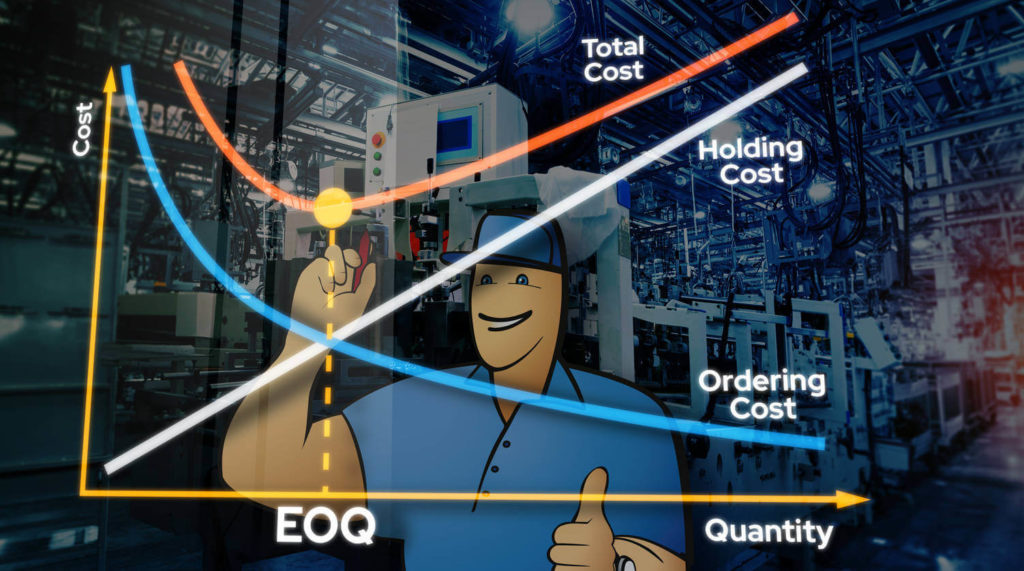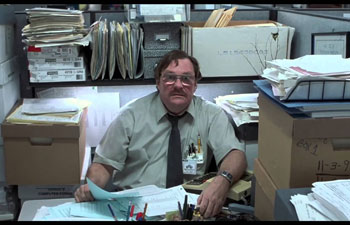What Is Economic Order Quantity (EOQ) and the EOQ Formula?
Economic order quantity is a supply chain management technique used to determine the optimal lot size per order. This is done in order to avoid stockouts and overstocking, thereby balancing inventory costs and opportunity costs.

You can also listen this article:
What is Economic Order Quantity (EOQ)?
Economic order quantity (EOQ, also known as economic buying quantity) is an inventory management method used to determine the optimal quantity of goods to buy at a time. The goal of EOQ is to minimize inventory costs while ensuring product availability by maintaining balanced inventory levels.
The EOQ model is typically used in make-to-stock environments where a product’s annual demand as well as its ordering and storage costs are constant. Simply put, if you know how much of a product will be sold at any given time, you can calculate when and how much you should order to avoid inventory shortages and overstocking.
The basic assumptions of EOQ are:
- Demand is constant
- Lead time is constant
- Ordering cost is constant
- Carrying cost is constant
Why is Economic Order Quantity important?
As already mentioned, the objective of the EOQ is to determine the ideal order size in units or quantities of materials to buy in order to avoid stockouts and overstocking.
But there are several additional benefits to using the economic order quantity model and ordering the ideal amount of inventory at the ideal time.
- Reduced carrying costs. As receiving and holding inventory always incurs some expenses for storage and handling, minimizing your inventory also minimizes the cost of holding the inventory.
- Reduced ordering costs. Each time you order something, you or your employees spend time on assessing your needs, drawing up documents, and putting in calls or writing emails. Ordering a certain amount of goods in longer intervals reduces the time spent on these activities, thereby reducing ordering costs.
- Tailored to your needs. You can use the economic order quantity to calculate the optimal order quantities that are specific to your business.
- Improved cash flow. Reducing inventory levels and minimizing the associated costs frees up cash that can be put to use elsewhere.
- Improved inventory turnover rate. The quicker your inventory depletion and replenishment cycles, the better your cash flow. But a high inventory turnover rate also allows you to be more flexible in the face of changes in demand or when new product iterations are rapidly released.
- Increased profitability. Reduced holding costs and ordering costs as well as better customer satisfaction achieved by being able to quickly fulfill orders inevitably lead to a heftier bottom line.
How to calculate the EOQ?
The economic order quantity formula consists of three inputs: ordering costs (also known as setup costs), holding costs (also known as carrying costs), and annual demand. Let’s take a closer look at them.
Ordering costs
Ordering costs or setup costs are expenses incurred in the process of ordering goods. These include costs related to:
- Preparing documentation such as purchase requisitions and purchase orders
- Incoming goods receipt and inspection
- Invoice and payment processing
- Shipping, if you pay for it
In the EOQ, ordering cost per order is used.
Holding costs
Holding costs or inventory carrying costs are fixed costs that are incurred by storing inventory. These include expenses related to:
- Storage area rent
- Tax and insurance
- Inventory depreciation or shrinkage
- Inventory handling
The formula for calculating the holding cost percentage of the total cost of your inventory is:
Holding cost (%) = (inventory holding sum / total value of inventory) x 100
Example
Let’s say a small furniture manufacturer is renting a workshop for $20,000/year. The warehouse area takes up 25% of the workshop, therefore the yearly rent for the storage area is $5,000.
Tax and insurance related to storing the goods amount to $3,600/year.
As the company manufactures hardwood furniture, inventory does not depreciate. There are some occurrences of inventory damage and shrinkage, which amount to $1,900/year.
The total cost of labor for inventory personnel is $75,000/year.
The total value of inventory is calculated by adding up the value of all unsold inventory stored in the warehouse. Let’s say the furniture manufacturer’s total value of inventory is $320,000.
Therefore, the holding cost percentage calculation would be as follows:
Holding cost % = (5,000 + 3,600 + 1,900 + 75,000) / 320,000 x 100 = 27%
That means holding cost makes up 27% of the total cost of an item. In the EOQ, annual holding cost per unit is used, though. That means we must take 27% of the total value of each SKU we calculate the EOQ for, i.e. 27% of the unit cost.
Annual demand
Annual demand is the number of products you expect to sell per year according to sales forecasts. EOQ can only be used if customer demand is consistent, e.g. there are no seasonal fluctuations.
Economic Order Quantity formula
The economic order quantity is calculated by taking the following steps:
- Multiply demand (D) by the ordering costs (S)
- Multiply the result by 2
- Divide this by the holding cost (H)
- Take the square root of the result
The EOQ formula is, therefore:
Q = √ (2DS / H)
Example
Let’s say a furniture manufacturer’s customer demand forecast tells them that they will sell 1500 tables this year. Thereby, they will need to order 1500 table tops from their supplier this year.
Let’s assume that their ordering cost per order is about $60 and a table top’s annual holding cost per unit is $30.
The EOQ calculation for the table tops would therefore look like this:
Q = √ (2 x 1500 x 60 / 30) = ~77 units
Therefore, the approximate number of orders this year would be 1500 / 77 = 19
Using EOQ with reorder point and safety stock
Economic order quantity is best used with other inventory management techniques such as reorder point and safety stock. While the EOQ specifies the lot size of each order, the reorder point is used to determine when an order must be placed for it to be fulfilled on time. Safety stock, however, is the inventory buffer kept just in case for times of unusual demand.
Reorder point
The reorder point formula is used to calculate the inventory levels where a replenishment order should be put in. When the number of units of an SKU you have on-hand drops to a certain level, The formula consists of three variables: supplier lead time, demand rate, and safety stock.
Read more about Reorder Point and Reorder Point Formula
Safety stock
In inventory control, safety stock formulas are used to calculate the optimal amount of buffer to keep on hand to avoid inventory shortages in case of unusually high demand. The inputs for safety stock depend on the specific situation, but the simplest formula is:
Safety Stock = Average Demand x Safety Days
There are, however, much more accurate formulas for calculating safety stock. Read about them in our article about Safety Stock.
Challenges of Economic Order Quantity
Amount of accurate data available
For correctly calculating EOQ, you must have accurate data available regarding demand, ordering cost, and holding cost. You must also have an inventory management system in place that provides you with the correct data regarding your inventory levels.
The EOQ also assumes that these inputs are fixed costs that stay the same throughout the year.
Seasonality and fluctuating demand
If the demand for your products fluctuates, using the EOQ will give you inaccurate results. For the EOQ to work, demand should be measurably consistent year by year. Getting the sales numbers from January and assuming that you will experience the same demand for the rest of the year might lead to inventory shortages or overages down the line.
Quantity discounts
Economic order quantity is not the best option if you are looking to exploit quantity discounts. For example, the EOQ might say that the ideal order quantity is 175 units but the supplier is offering a significant discount for quantities over 200. In this case, the numbers have to be weighed differently.
Using EOQ with an ERP/MRP system
Even though ERP/MRP systems do not automatically calculate the economic order quantity for your stock keeping units, the data collection capacity of such systems could prove very useful in calculating it.
ERP/MRP systems are designed for collecting and analyzing data, therefore if you have been using this kind of software for several years, you can easily pull the necessary metrics regarding your annual demand from the system. In addition, you can always see what you have in stock and you can calculate your material requirements for upcoming orders.
Besides that, ERP software automates many clerical tasks related to ordering and inventory management, which can aid in minimizing purchase costs and holding costs.
An ERP/MRP system also facilitates the use of many other supply chain management techniques that are not so dependent on consistent demand.
Today, there are many ERP/MRP systems available that are designed specifically for small businesses. These software solutions are affordable, easy to use, and provide small businesses with functionality that was previously available only for large enterprises.
Key takeaways
- Economic order quantity (EOQ) is an inventory management method used to determine the optimal quantity of goods to buy at a time to minimize costs and maintain balanced inventory levels.
- The EOQ model is used in make-to-stock environments where demand as well as ordering and storage costs are constant.
- The benefits of using EOQ are reduced carrying and ordering costs, improved cash flow, increased inventory turnover rate, and increased profitability.
- The inputs for the EOQ formula are ordering costs, holding costs, and annual demand.
- The reorder point formula and safety stock formulas are used in conjunction with EOQ for optimal inventory management.
- The main challenge of the EOQ is the availability of accurate data.
Frequently asked questions
What is economic order quantity (EOQ)?
Economic order quantity (EOQ) is a formula used to determine the optimal order quantity that balances the cost of ordering and holding inventory.
What is the formula for calculating economic order quantity?
The formula for EOQ is EOQ = √(2DS/H), where D is the annual demand, S is the ordering cost, and H is the carrying cost of inventory.
What are the advantages and disadvantages of using the EOQ?
The advantages of EOQ include reduced ordering and holding costs, while disadvantages include assumptions that may not match real-life conditions.
What are the advantages of a large order quantity?
The advantage of a large order quantity is reduced ordering costs per unit. However, a disadvantage is the increase in holding costs and risk of stock obsolescence due to the need to store and maintain a larger amount of inventory.
You may also like: What Is Minimum Order Quantity (MOQ)?




